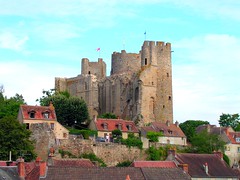 The Allier also boasts the forest of Tronçais, the largest oak forest in Europe. It was planted by Louis the 14th’s chancellor, Colbert just before the French Revolution. He persuaded the King that in order to have enough oak to replenish the French fleet of warships in 150 years time they needed a substantial programme of planting. Oak trees are indigenous to the Bourbonais and they grow in all the hedgerows. Now the forest supplies the finest oak casks for the wine industry, abundant wood for building, furniture and flooring, as well as renewable energy for heating. Most of the Allier is between 150 and 400 metres above sea level with mountains of around 1,500 metres in the south east of the department. This means that the weather tends to be warm and relatively dry. December, January and February can be very cold with heavy night frosts but are usually bright and sunny during the day. It is not unusual to be able to sit outside for lunch during much of November and occasionally in February. This contrasts with the Puy de Dôme, the Cantal and the Haute Loire where the winters start in September and spring comes late. On the other hand, if you live in the centre of the Allier it is possible to be on the ski slopes in an hour and a half.
The Allier also boasts the forest of Tronçais, the largest oak forest in Europe. It was planted by Louis the 14th’s chancellor, Colbert just before the French Revolution. He persuaded the King that in order to have enough oak to replenish the French fleet of warships in 150 years time they needed a substantial programme of planting. Oak trees are indigenous to the Bourbonais and they grow in all the hedgerows. Now the forest supplies the finest oak casks for the wine industry, abundant wood for building, furniture and flooring, as well as renewable energy for heating. Most of the Allier is between 150 and 400 metres above sea level with mountains of around 1,500 metres in the south east of the department. This means that the weather tends to be warm and relatively dry. December, January and February can be very cold with heavy night frosts but are usually bright and sunny during the day. It is not unusual to be able to sit outside for lunch during much of November and occasionally in February. This contrasts with the Puy de Dôme, the Cantal and the Haute Loire where the winters start in September and spring comes late. On the other hand, if you live in the centre of the Allier it is possible to be on the ski slopes in an hour and a half.  The Allier also boasts more than 300 Romanesque churches, more than 500 moated and renaissance castles, manor houses, stately homes and fortified farms. There are medieval villages, reasonably priced cafés, bars and restaurants serving the local gastronomy. Souvigny, the historical capital of the Bourbonnais boasts the first monastery to open outside Cluny which is still active today. The Allier is Europe’s last unspoilt river and you can spot a salmon from the bridge linking the Bocage Bourbonnais to the Sologne Bourbonais east of Moulins. There are Jazz festivals in the Bocage; mediaeval festivals; classical music in the churches. Village fêtes and brocantes, a cross between a boot sale and antiques fair, throughout the summer; old book fairs, riding, golf, tennis, cycling, skiing, walking, canoeing down the gorges. Or you can simply enjoy the unspoilt countryside and its traditional way of life. This is a region begging to be discovered with some of the least expensive property in France – check out Allier Property. Adrian Collett
The Allier also boasts more than 300 Romanesque churches, more than 500 moated and renaissance castles, manor houses, stately homes and fortified farms. There are medieval villages, reasonably priced cafés, bars and restaurants serving the local gastronomy. Souvigny, the historical capital of the Bourbonnais boasts the first monastery to open outside Cluny which is still active today. The Allier is Europe’s last unspoilt river and you can spot a salmon from the bridge linking the Bocage Bourbonnais to the Sologne Bourbonais east of Moulins. There are Jazz festivals in the Bocage; mediaeval festivals; classical music in the churches. Village fêtes and brocantes, a cross between a boot sale and antiques fair, throughout the summer; old book fairs, riding, golf, tennis, cycling, skiing, walking, canoeing down the gorges. Or you can simply enjoy the unspoilt countryside and its traditional way of life. This is a region begging to be discovered with some of the least expensive property in France – check out Allier Property. Adrian Colletthttp://www.coeurdelafrance.co.uk & http://propertyfrench.com
No comments:
Post a Comment